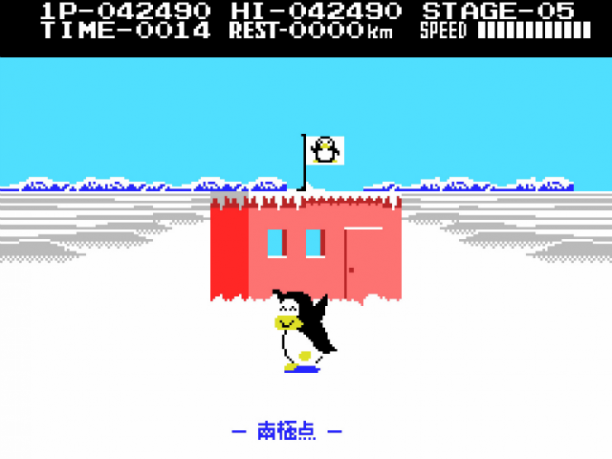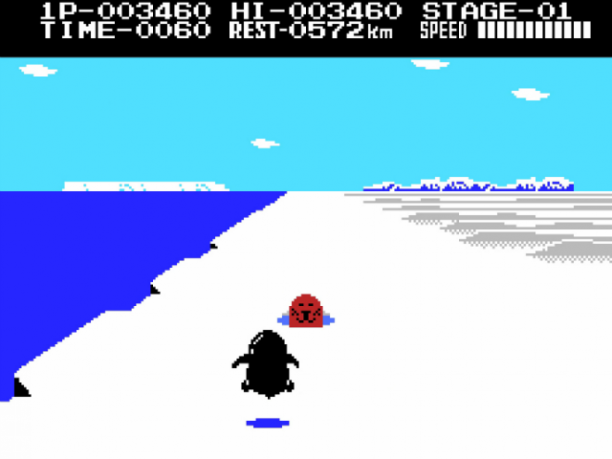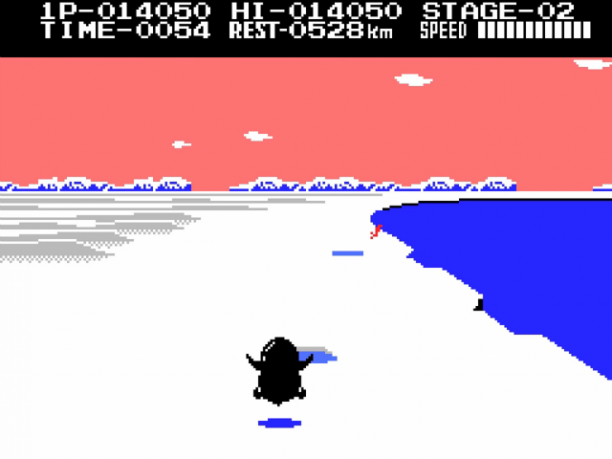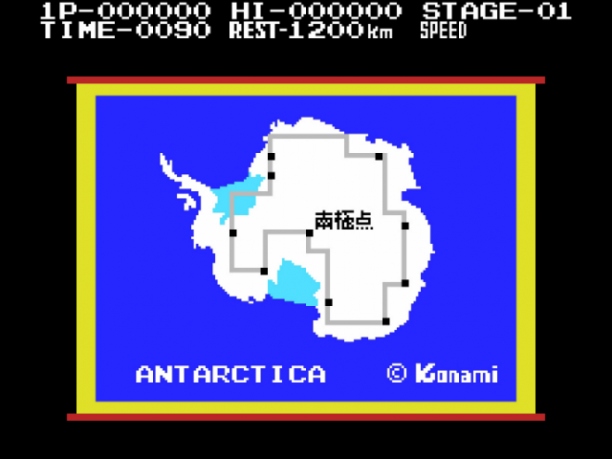
Pixel Gallery
Antarctic Adventure
Retro Platforms: ColecoVision, Famicom, MSX
Platform Reviewed: MSX
Stressed out from work demands in real life? Searching for a wacky and cheerful game to help you temporarily escape from reality? Well, never fear, because Antarctic Adventure is here! Initially released by Konami for the MSX computer in Europe and Japan, this is a simple racing-like title that features an adorable penguin named Penta, a character who would later become a recurring mascot in the Parodius shoot ‘em up games. With running speeds that mathematically surpass even the world’s fastest hedgehog, Penta’s mission is to race the clock to reach various research stations located around the South Pole, and the game challenges you to complete as many levels as possible. The graphics are cute, the gameplay’s fast-paced, and the overall experience is a fairly relaxing one. It’s not without its faults though, but let’s examine the components of this strange tale, shall we?
Graphics
In terms of its basic presentation, Antarctic Adventure looks simple yet charming. The star penguin and seal enemies have convincing levels of 3D depth, and their expressions are cute to match the bright mood of the game. Penta also has some funny animations that play at the ends of levels, with him doing hand waves and one-footed stands that are accompanied by adorable faces of happiness. During the gameplay, attention is given to moving and jumping; there are minor details such as the flapping of arms during a jump, and the casual shimmying of legs back and forth during running. There’s also graphical feedback to colliding with pits and enemies, although there’s not much frame variety since the movements seem limited to a few sprites. But except for sometimes being too simple, as well as some layout changes looking instantaneous, my only other complaint with the animation is that the MSX tends to make the gameplay seem somewhat choppy at times; thankfully, this doesn’t noticeably affect the gameplay, and is more or less just an expected hardware limitation.
The art style of the stage environments is pleasant in short-term, but things get repetitive early on. On the plus side, there’s some simple landscape detail to distinguish the sides of the screen from the playable area, and mountain backgrounds and clouds are also present; the clouds move constantly while the mountains only move when turns are being made, helping to convey a sense of position within the South Pole. Draw distance is also fair for the gameplay, and running along curves provides perceptual feedback. Speed plays a big role in Antarctic Adventure, and this sense of speed is conveyed through the graphics, even if it’s basic at times. And I would be lying if I said that the randomized country flags which appear at each station weren’t a nice touch. Now on the negative side, once you finish a level, you’ve pretty much seen all of the environmental variety that the game has to offer. Even though the obstacle placements might change over time, every level visually involves the same kind of terrain, and the only notable background change is that the sky’s occasionally a different color. Some people won’t see this as a big deal, and it’s not a deal breaker, but some more variety would have been nice.
Audio
Are you a fan of The Skaters’ Waltz, the classical music piece? Well, I hope you are, because it’s the only song that plays during the levels of the game; other jingles will briefly play during transitions like starting the game or reaching the end of a level, but there aren’t different songs for different stages of the game. To the game’s credit though, this song is actually implemented really well using the MSX hardware; some technical limitations may be present, but there are multiple simultaneous instruments, the mood is extremely lovely and relaxing, and the song is upbeat and complements the gameplay. Unlike most other arcade games though, this song plays for a notable majority of the game, and while it sounds great, the lack of variety starts to show a few levels into the game. Now as for the sound effects, they work just fine. There aren’t too many of them, but there’s the right amount considering the game’s simplicity, and the sound effects properly reflect the controls and obstacle collisions.
Gameplay
Speed and successful maneuvering are the gameplay’s key components. You’re given a time limit that counts down in real seconds, and the goal is to help Penta reach a labeled distance before that time runs out. Nothing can kill you, but hitting obstacles does slow down the penguin, so you need to avoid hitting small pits, crazy seals, and wide pits by moving left and right, and jumping. The light blue pits are easily distinguished from the dark blue ones, and are smaller in size; hitting these pits or an emerging seal will stop Penta’s current speed and bounce him sideways for a few seconds, causing you to waste time. The darker and larger pits, on the other hand, can be fallen into, and you have to tap a button a few times to help Penta climb out of the pit. Both types of pits can be jumped over, but this won’t work against the seals. Jump spamming is also discouraged since your mid-air movement is slower than on-ground side-stepping. While they are the only ones in the game, the three aforementioned obstacles have different rules than one another, so their variety is appreciated and helps make the gameplay more complex. Even though the dodging is simple, it’s actually pretty fun!
Another component to the controls is managing Penta’s speed. You’re always moving forward, but by holding up or down, you can change how fast the penguin moves, and you will need to be going at high speeds in order to reach the level ends in time. If there is a slight complaint to this, it’s that there’s not much reason to slow down due to the strict time limit; you might want to avoid certain obstacles, but you basically always want to be going at max speed. This is minor though, as racing through the levels at quick speeds is actually pretty fun, and the gameplay is actively engaging. Every second that you’re in control matters, and the graphics work together with the gameplay to provide intense feelings of fast travel. For an old arcade-styled game, this is actually fairly impressive, even if some jumps have to be really precisely timed in the later levels due to this.
One smaller thing to mention is that at several points during levels, the land ahead will involve curves, and your movement’s affected during these turns. You automatically move away from the seaside, and can move even faster if you aim in that same direction. Inversely, if you try to move toward the seaside during these turns, then your movement in that direction will be slower than it would normally be outside of the turn. Personally, I think this offers some interesting variety to the navigation, but it can sometimes be slightly awkward to adjust to. I suppose your controls may feel less precise during these sections, but since they don’t make it impossible to avoid obstacles, only harder, then they work fine. This isn’t even necessarily a criticism; on the contrary, it’s conveyed well through the graphics, and it helps diversify the gameplay… slightly.
This is unfortunately where some more noticeable issues with Antarctic Adventure appear, namely that it’s too repetitive and lacks variety over time. As mentioned earlier, every stage shares the same visual design, and new obstacle types aren’t introduced in later levels. Pits and seals appear more often, the jumping starts allowing less room for error, and the game’s difficulty curve manages to be appropriately scaled for the most part, but the core mechanics to each level never change. There aren’t new enemies for instance, nor is there even a change in scenery such as having a cave level with some changes to the game’s friction. Even though it doesn’t take long to see all of the game’s levels, these levels offer little variety, which isn’t a problem if you’re playing the game in short bursts, but it’s kind of disappointing if you’re playing the game to beat it. The lack of an ending, merely a looping of levels but with an increased difficulty, reinforces this; it does makes some sense considering the score focus, but again, there should be more variety. Ultimately, the game’s control mechanics work fine and offer plenty of relaxing fun, but the overall presentation aspects could benefit from notably changing things more over time.
There are also some smaller things to note, one of which gives you something to do besides simply avoid obstacles. Antarctic Adventure is a points-oriented game, and in addition to distance and time bonuses, you’re also encouraged to collect flags and fish to increase your score, giving some slight secondary goals during the gameplay. These collectables also add some more strategy to your movements, as going for bonus points can involve making risks with regards to reaching the level ends in time. Speaking of which, the countdown starts getting less generous with later levels, and if you don’t reach the goal before the timer hits zero seconds, then it’s game over. That’s right, there aren’t any extra lives here; the game just ends and you have to start over. It seems like a somewhat harsh punishment, but if you’re playing the game with the goal of making a high score, then it kind of makes sense. Still, I would have liked to see an extra two tries, or even just a level select code, at least.
Conclusion
In terms of short-term play, Antarctic Adventure is a good choice of a game that provides some fast-paced yet simplistic fun, and this is definitely helped by the game’s cute and relaxing winter presentation. The controls are also responsive, and I like the audio despite the lack of additional songs. I do, however, have a larger criticism of Antarctic Adventure with regards to its longer-term play, and that’s that the gameplay’s variety feels limited over time. Some additional items, changes in location, or even just a few new enemies would have helped with this, and the company actually seemed to learn from this when they eventually made Penguin Adventure, the game’s official sequel. But honestly, despite what I’ve said, I’m still going to recommend Antarctic Adventure for fans of arcade, racing, or penguin-related games, as it’s ultimately an enjoyable game that definitely works as a good stress relief. There’s more good than bad here, and honestly, who could say no to the cute face of Penta anyway?
Some screenshots used for this review were captured from a tool-assisted speedrun performed by Vampier. You can find that video by clicking here.



